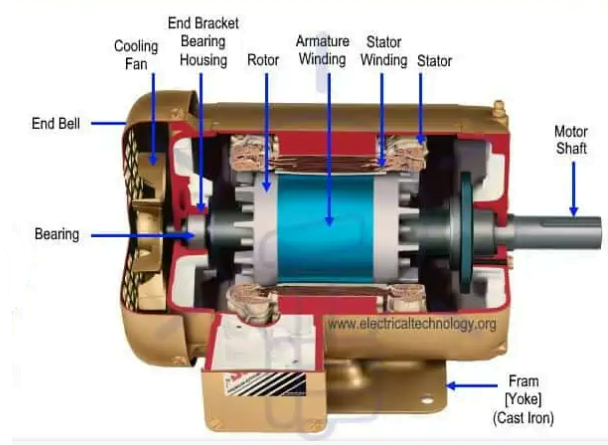An electric motor is a device which is convert the energy from electrical to mechanical. The first electric motor was invented in the year 1886 by Frank Julian Sprague.
Electric motors are devices that convert electrical energy into mechanical energy. There are various types of electric motors, each designed for specific applications based on factors such as speed, torque, power requirements, and environmental conditions. Here are some common types of electric motors:
There are generally two types of electric motors.
- AC motor
- DC motor
AC motors require little power to start and are adaptable for speed control. On the other hand, DC motors are widely used because they are simple to install and have a lower initial cost for low-power units than AC motors.
Applications of Electric Motors
Applications of electric motors in daily life are such as fans, blowers, machine tools, pumps, power tools, blender machines, grinders, washing machines, hair dryers, and airport conveyor belts (baggage carousels). etc.

Table of Contents
DC Motors:
Direct current (DC) motors operate using electricity supplied in one direction, creating a magnetic field that interacts with the armature to produce rotational motion.
Types of DC motors include:
Brushed DC Motors:
These motors have brushes that deliver current to the armature, causing it to rotate. They are simple and cost-effective but require regular maintenance due to brush wear.
Brushless DC Motors (BLDC):
BLDC motors use electronic commutation instead of brushes, offering higher efficiency, reliability, and longer lifespan. They are widely used in various applications, including appliances, automotive, and industrial equipment.
AC Motors:
Alternating current (AC) motors operate using alternating current, which periodically reverses direction. AC motors are more commonly used than DC motors due to their simplicity and efficiency.
Types of AC motors include:
Induction Motors:
These motors rely on electromagnetic induction to produce rotational motion. They are simple, rugged, and widely used in industrial and commercial applications.
Synchronous Motors:
Synchronous motors rotate at a constant speed synchronized with the frequency of the AC power supply. They are used in applications requiring precise speed control, such as industrial machinery and synchronous clocks.
Single-Phase Motors:
These motors operate on single-phase AC power and are commonly used in residential appliances such as fans, pumps, and compressors.
Three-Phase Motors:
Three-phase AC motors are more efficient and powerful than single-phase motors. They are widely used in industrial applications such as pumps, compressors, and conveyor systems.
Specialty Motors:
Servo Motors:
Servo motors are high-precision motors designed for accurate control of angular or linear position, velocity, and acceleration. They are commonly used in robotics, CNC machines, and automated manufacturing systems.
Stepper Motors:
Stepper motors divide a full rotation into a series of steps, allowing precise control of position and speed. They are used in applications such as 3D printers, CNC machines, and robotics.
Linear Motors:
Linear motors produce linear motion directly without the need for rotary-to-linear conversion mechanisms. They are used in applications such as high-speed trains, conveyor systems, and precision positioning equipment.
Leave a Reply